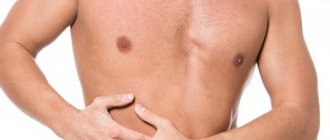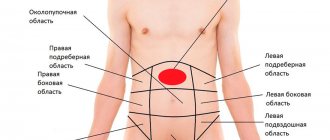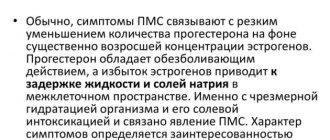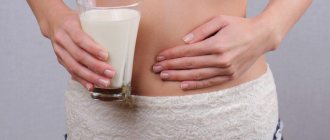Diagnostics
Bloating and pain in the right side have many causes.
There may be external factors, such as bruises. Internal causes are more difficult to diagnose, especially when it comes to the digestive system, where all organs are close to each other and closely interact. The primary method of diagnosis is palpation, in which the doctor carefully feels the abdomen from all sides. If there is severe pain, a doctor should be called immediately. If there is heaviness in the abdomen and bloating without much pain, you can diagnose yourself.
Lying on your stomach, relax and lightly press your fingers on the areas of discomfort. Feel if the soreness increases or decreases. It is necessary to probe deeply, but carefully, avoiding sudden movements. We must try to understand for ourselves and for the doctor (in order to clearly explain to him) what is happening. There is a nagging pain, there is a bursting, throbbing, stabbing and sharp pain.
There is distension or bloating in the abdomen without pain. After palpation, the specialist decides on further diagnostics, which may require a general and chemical blood test, ultrasound or x-rays.
Gynecological causes of pain
Bloating and pain in the abdominal area may indicate the development of diseases of the reproductive system in both men and women.
For representatives of the stronger sex, discomfort in the lower abdomen may be a sign of damage to the prostate gland:
- Hypothermia, sedentary work, constipation, prolonged abstinence and infection in the prostate tissue can lead to the development of an inflammatory process. With prostatitis, the patient experiences nagging pain in the pelvic area, the urge to urinate frequently, and urine comes out in a thin stream. With chronic pathology, the process of emptying the bladder becomes difficult and becomes very painful.
- In older men, as a result of changes in hormonal levels, proliferation of glandular tissue may be observed. Prostate adenoma is characterized by such symptoms as intense sharp pain in the lower abdomen, difficulty and scarcity of urination.
If women experience pain in the lower abdomen, they should consult a gynecologist, since the symptom may be a sign of one of the following pathological conditions:
- The development of the fertilized egg outside the walls of the uterus can pose a serious danger to the patient’s life. An ectopic pregnancy can lead to rupture of the fallopian tube or ovary, resulting in infertility or death. Characteristic symptoms of the pathology are disturbances in the menstrual cycle, bleeding from the vagina, nagging pain in the lower abdomen, and signs of toxicosis.
- Rupture of ovarian tissue is a dangerous condition in which the patient experiences severe pain. Characteristic symptoms are decreased blood pressure and pale skin, indicating internal bleeding. Uncontrollable vomiting and fainting are possible. If these signs are detected, the patient should be immediately transported to a hospital hospital.
- The development of viral or bacterial infections that progress against the background of stress, hypothermia and decreased immunity can cause acute inflammation of the appendages. The pathology is characterized by the following symptoms: pain radiating to the right side, increased body temperature, intoxication, nausea, vomiting, general weakness, drowsiness.
Based on data on the location and intensity of pain, the therapist will prescribe a comprehensive examination and consultation with a specialist.
Depending on the identified cause of discomfort, conservative treatment or surgical intervention should be prescribed.
jeludokbolit.ru
If the intestine on the right hurts, this may indicate a host of diseases, but sometimes there are non-pathological reasons behind it. Most often, such pain is associated with the well-known inflammation of the appendix (appendicitis), although this is not the only pathology that can make itself felt in this way. If the pain bothers you frequently, or the pain lasts more than an hour, you should consult a doctor, as immediate treatment is most likely needed.
Causes of bloating and pain in the right side
Bloating, heaviness in the abdomen and slight soreness are not so uncommon in everyday life. This can lead to:
- nervous tension;
- great physical activity;
- critical days or ovulation period;
- increased consumption of fiber (cabbage, radish);
- unhealthy diet or overeating;
- fatty and overcooked foods;
- intoxication with alcohol, medications or chemicals;
- eating large amounts of halva, ice cream or chocolate;
- carbonated drinks.
If the bloating and heaviness go away after a few hours, then you can calm down. If the condition recurs or develops into long-term and acute pain, then we can talk about serious diseases, which we will now talk about.
Possible diseases and their symptoms
Bloating and soreness can occur with a variety of diseases, but characteristic symptoms, as a rule, tell us about the presence of a specific problem.
| Nature of pain, symptoms | Disease |
| Abdominal distension, intestinal spasms, fermentation, constipation | Flatulence |
| Jaundice, bright colored urine, weakness, bloating, dull, dull pain on the right side | Liver thrombosis, hepatitis, cirrhosis, helminthiasis |
| Acute, incessant pain on the right, severe swelling on the lower right + pain may indicate the onset of peritonitis | Appendicitis |
| Severe pain, diarrhea, increased sweating, heartburn. The pain appears an hour and a half after eating and increases gradually. Pain decreases after digestion of food | Ulcer |
| The simultaneous appearance of a feeling of hunger and pain that radiates to the forearm | Duodenitis |
| Abdominal bloating, soreness | Intestinal upset, obstruction |
| Bloating, poor appetite, diarrhea or constipation, nausea during and immediately after meals, heartburn | Gastritis |
| Bloating immediately after eating, diarrhea, pain goes away after visiting the toilet | Irritable bowel syndrome |
| Nausea, vomiting (sometimes with blood), severe weight loss, lack of appetite, increased abdominal size, pale skin. | Stomach cancer |
| Severe pain in the pit of the stomach or severe girdle pain after eating. | Pancreatitis |
| Spasms in the rectum, pain in the right hypochondrium. | Pylorospasm |
The cause of pain can be not only problems in the gastrointestinal tract or liver. They can be due to arterial thrombosis, pyelonephritis, heart failure.
Therefore, the help of a specialist is necessary to determine the disease, or even immediate surgical intervention. You need to understand where and how it hurts, remember when the pain started, analyze why it arose and whether it happened before. Only you can know all this, so by telling your doctor as many details as possible, you will jointly solve problems faster and more efficiently.
Causes of bloating
Bloating in the lower abdomen on the right brings people a lot of unpleasant sensations, and everyone tries to get rid of the symptom as quickly as possible.
To choose the right treatment regimen, it is important to determine the causes, and there may be several of them:
- Accumulation of gases in the intestines. Most often, the provoking factor is poor nutrition, especially if you overuse sweet or rich foods.
- Dysbacteriosis. With this diagnosis, the beneficial intestinal flora dies, and pathogenic bacteria come to replace it, disruption of the digestive system occurs, heaviness in the right hypochondrium, bloating and other unpleasant sensations begin.
- Infection of the intestines with infections and parasites.
- Diseases of the gastrointestinal tract, especially pronounced bloating in the lower abdomen on the right, appears when the functioning of the pancreas is disrupted, when the body lacks enzymes for processing food.
- Intestinal obstruction leads to the inability to remove gases normally.
- Swallowing large amounts of air during meals.
Sometimes the cause is the result of heavy consumption of soda. In patients with gastritis or irritable bowel syndrome, bloating on the lower right side appears quite often, but the pain goes away.
Digestive system
Hepatitis
The liver is the main right-sided organ in the human body and can regenerate well. But damage by infectious viruses of hepatitis A and B is possible. The nature of the pain is aching with periodic sharp attacks. Location: right hypochondrium. Hepatitis may not manifest itself for some time (up to almost three weeks). The virus then enters the liver cells and creates a serious inflammatory process. Symptoms of hepatitis are:
- pain heaviness in the right side;
- weakness and apathy;
- intoxication;
- yellowness of the skin, whites of the eyes;
- dark, cloudy and foamy urine;
- light cal.
Hepatitis in the acute period is treated only inpatiently and the more timely the treatment is, the more effective and quicker the cure.
Pancreas
With pancreatitis, the pain can be very different depending on the extent of the inflammatory process - dull, sharp, nagging, encircling, etc. If the form is edematous and the right side of the abdomen is swollen, the organs become larger and put pressure on the nerve endings, the ducts are blocked, the pain is severe.
Sometimes with pancreatitis it can spread throughout the body, radiating into the spine, into the collarbone. It may not be related to food intake, so it is not easy to make an accurate diagnosis; it is impossible to do it yourself - experts know well that the symptoms of pancreatitis can coincide with the symptoms of a heart attack or angina.
Acute pancreatitis will be expressed by vomiting after eating, constipation or diarrhea. As the disease progresses further, bile will begin to appear in the vomit, and vomiting itself can lead to serious dehydration. Inflammation of the pancreas can occur unexpectedly after a heavy meal; it can be provoked by certain medications - antibiotics, cytostatics, etc.
Biliary dyskinesia
Disruption of the biliary tract occurs due to a birth defect, poor nutrition, and increased emotional stress.
Pain appears from time to time in the area of the right hypochondrium, and the phenomenon of dyspepsia (alternating constipation with diarrhea) is observed. If the stomach is swollen, and the pain spreads from the right hypochondrium to the back, going up to the right collarbone, this is an acute form of dyskinesia. In this case, there is nausea and even regular vomiting.
The bile ducts can become clogged after severe stress and trauma - physical and psycho-emotional.
Flatulence
The accumulation of gases in the intestines causes unpleasant distension of the intestines and can cause acute periodic spasms.
Fermentation begins in the intestines and at the same time problems with stool arise. Up to 20 liters of gases circulate in a healthy intestine, which are produced during various processes of food breakdown and its interaction with gastric juices. Gases are eliminated naturally and usually without problems. If the diet is incorrect, a large amount of feces and metabolic disorders create accumulations of gases. There are many causes of flatulence:
- poor nutrition;
- dysbacteriosis;
- a large number of gas-forming bacteria;
- lack of normal gastrointestinal activity;
- enzyme deficiency;
- increased pressure in the gastrointestinal tract during high altitude climbs;
- stress.
There are many foods that cause flatulence. We must learn to combine them correctly in dishes; we must not overeat. You will be surprised to see this list of products, they are all useful, but if not handled correctly, they cause flatulence:
- ice cream;
- celery, cabbage, radishes, carrots, onions;
- apples, pears, plums, apricots, grapes;
- wholemeal bread, bagels, rolls;
- beans, beans, peas;
- bran, wheat germ, corn, oats;
- beer;
- mushrooms;
- carbonated drinks;
- raisin.
Gallbladder pathologies
The main symptom of inflammatory processes, the formation of solid fractions and general disruption of the biliary tract is pain in the right side.
Experts associate the occurrence of cholecystitis with impaired motility of the gallbladder, as a result of which the bile stagnates and becomes thicker.
When pathogenic microflora gets inside, an inflammatory process develops. The causes of the pathology are called:
- congenital anomalies of the structure of the gallbladder or any conditions associated with prolapse or pressure on the walls of other organs;
- a sharp change in diet, a strict diet, switching to vegetarianism, overeating, abuse of fast food, fatty, fried, spicy foods, alcoholic beverages;
- formation of solid fractions in the biliary tract;
- infection with helminths, etc.
Symptoms of the pathology are pain in the right side, flatulence, vomiting, lack of appetite, bloating.
Complications of the disease can include perforation of the gallbladder wall, purulent processes affecting neighboring organs.
Treatment of cholecystitis consists of a comprehensive intake of broad-spectrum antibiotics, anthelmintic drugs, enzyme therapy, and restoration of water balance after intoxication.
After consultation with a specialist, traditional medicine methods that accelerate gallbladder peristalsis can be used.
If acute pain in the abdominal area is accompanied by severe nausea, intense vomiting, an increase in temperature to low-grade levels and a change in skin color, a specialist should prescribe a comprehensive examination to confirm the diagnosis of cholelithiasis.
The pathogenesis of the disease is associated with changes in the composition of bile, resulting in the formation of small solid fragments that settle on the walls of the organ.
Subsequently, the stones grow, forming stones that block the bile ducts.
One of the most common pathologies is biliary dyskinesia. There are two types of gallbladder activity disorders:
- Hyperkinetic dyskinesia is manifested by active contractions of the walls.
- Hypokinetic is characterized by weak motility of the gallbladder.
Experts call the main cause of dyskinesia psycho-emotional disorders that manifest themselves against the background of professional, family and other difficulties.
Pathology can develop as a result of allergic reactions, eating disorders, overeating or poor nutrition, obesity.
Symptoms appear depending on the type of pathology. With spastic dyskinesia, pain in the right side is severe and acute, accompanied by nausea and profuse vomiting.
In the hypotonic form, the pain is nagging, bursting, the patient suffers from bloating, belching with a bitter taste, and decreased appetite. The patient becomes irritable and has problems sleeping.
urinary system
Abdominal bloating with or without pain in the initial period may be due to urolithiasis.
The very first sign of it is pain, which can be dull, weak, or unbearable. This pain is constantly present, it may be subtle, but it will still be there. Renal colic is localized in the side or lower abdomen. The attacks last from 20 minutes to an hour. The urine becomes reddish, sometimes there is blood and “sand” in it.
There may be nausea, vomiting, increased pain when urinating, or an unexpected urge to urinate. Sometimes urolithiasis does not manifest itself for a long time, but begins with bloating without significant pain.
Pain after eating in the right hypochondrium with cholecystitis
If, in addition to painful sensations, there is bitterness in the mouth, one can assume cholecystitis, the main symptom of which is vomiting with bile. Other symptoms that are present with this disease:
- white coating on the tongue;
- temperature increase;
- insomnia;
- feeling of bloating;
- cardiopalmus;
- headaches;
- pain on the right.
If cholecystitis is in the acute period, then there is unbearable pain in the right hypochondrium, which radiates to the shoulder, under the shoulder blade, and high temperature. In this case, you need to urgently call a doctor, since delaying the process can lead to peritonitis.
In most patients, cholecystitis begins against the background of cholelithiasis, when the gallbladder is irritated, pressure inside the organ increases, and stones penetrate inside, causing inflammation and even necrosis.
Symptoms
If pain and bloating are in no way related to diseases, then additional symptoms should not appear.
In the presence of gastrointestinal diseases, additional signs appear:
- Feeling of a stone in the stomach.
- Stool disturbances, as well as disruptions in the frequency of bowel movements.
- Change in stool consistency.
- Pieces of food appear in the stool that could not be digested.
- Diarrhea is possible, which occurs 10 times a day.
- Lost appetite.
- My stomach is constantly rumbling.
- After eating, a burning sensation in the esophagus begins.
- Belching with smell.
If the cause is hidden in liver dysfunction, then additional symptoms include:
- Nausea and vomiting, and the mass itself contains bile.
- Abdominal distension.
- The skin turns yellow, which may indicate hepatitis.
- The patient's weight decreases due to a sharp loss of appetite, as well as frequent diarrhea.
- There is constant weakness in the body and fatigue quickly sets in.
- An irritated man.
- The mood is constantly changing.
- The temperature rises and remains around 37.2-37.8 degrees.
- The liver increases in size.
Often a sign of bloating on the right side and pain indicates inflammation of appendicitis. To understand 100%, it is important to understand the main symptoms of inflammation:
- Nausea, accompanied by vomiting.
- A sharp increase in temperature, which increases along with the deterioration of the general condition.
- Severe abdominal pain.
- Increased sweat production.
- Increase in pressure.
If all the symptoms are present and measures are not taken, then death is possible. Often, symptoms may indicate osteochondrosis in the lumbar region.
The disease can be confirmed by the following signs:
- Frequent back pain.
- Decreased sensitivity in the hips.
- Constipation.
- Women's menstrual cycles are disrupted.
- Sexual activity is reduced.
Symptoms may be supplemented depending on the severity of the disease. If the pain and bloating are constant, and with exercise the symptoms become stronger, then we must talk about the presence of heart disease or the vascular system.
Characteristic symptoms:
- Dyspnea.
- Heaviness under the ribs, which is accompanied by pain.
- Pressure surges.
- Heaviness in the chest.
- Nausea.
- Heavy sweating.
If there is a suspicion of at least one disease based on the indicated symptoms, then you should immediately contact a doctor for assistance.
Timely examination allows you to start treatment on time, eliminating consequences.
Reproductive system
In gynecology, bloating is less typical, but it may become distended in the following cases:
- cyst (swelling and periodic pain);
- adnexitis (possibly bloating and aching pain in the chronic form and sharp pain in the acute form);
- ectopic pregnancy (bloating and aching pain);
- menstrual irregularities;
- ovulation period;
- beginning of pregnancy.
Men also often have lower abdominal pain and bloating:
- injuries;
- infections;
- inflammation in the testicles, penis;
- posts;
- vesiculitis;
- prostatitis;
- colliculitis.
In men, diseases in the reproductive system are common, which cause pain and discomfort in the abdomen, and here independent palpation will not help, only a specialist is needed.
Treatment
Sometimes people are confused about which doctors to go to when pain occurs.
In any case, you can first contact a therapist, who, after an initial examination, will refer you to a specialized doctor. Gastrointestinal diseases - a gastroenterologist. Suspicions of women's diseases - a gynecologist, men's - a urologist. The most important thing to do when you have pain is to adjust your diet. You can apply cold to the stomach, drink painkillers, which are in your home medicine cabinet . But you cannot use more complex drugs on yourself; only the doctor will prescribe the necessary drug, its dosage and course.
If the bloating is temporary and you know where it comes from, you can use folk remedies - decoctions of parsley, dill, calendula.
If there is bitterness in the mouth, you can temporarily use light choleretic agents - Allohol, Karsit, Holosas. You can alleviate the condition of the liver with a decoction of rose hips with sorbitol. Chamomile is drunk for inflammatory processes in the gastrointestinal tract, and for indigestion - calendula or yarrow.
But you can alleviate the condition if you know for sure that the problem arose after overeating or eating junk food. If the discomfort continues and the pain intensifies, do not expect more serious problems.
Nutrition for flatulence
For all problems in the gastrointestinal tract, in addition to drug therapy, nutrition is of great importance, in which the following rules are observed:
- Products should only be boiled, baked or steamed;
- First courses are made without frying;
- The bread must be yesterday's bread;
- Fruits – only sweet ones;
- Drinks – natural, highly diluted juices or compotes.
The following products are prohibited:
- Pork, lamb;
- Fatty, spicy, smoked;
- Sour;
- Spicy cheeses;
- Confectionery products (except biscuits in small quantities);
- Strong tea and coffee;
- Fish broths;
- Raw garlic and onions.










